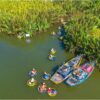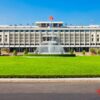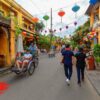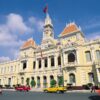Vietnam continues to grow in popularity as a travel destination for Australians, thanks to its rich culture, delicious cuisine, breathtaking landscapes, and warm hospitality. If you’re an Australian planning to explore this vibrant Southeast Asian country, it’s essential to stay updated on the latest travel requirements and practical tips to ensure a hassle-free trip.
This comprehensive guide covers how to travel to Vietnam from Australia with the most recent updates for 2023, 2024, and 2025, including visa regulations, flights, COVID-19 travel policies, and insider advice.
Why Visit Vietnam? Highlights for Australian Travelers
Before diving into the logistics, here are some reasons Vietnam appeals strongly to Australians:
-
Proximity: Vietnam is about 7-9 hours flight from Australia’s east coast, making it a convenient holiday spot.
-
Affordability: Vietnam offers excellent value for money, from accommodation and transport to food and activities.
-
Diverse Experiences: Whether it’s cruising the mystical Halong Bay, cycling through ancient Hoi An, tasting street food in Hanoi, or relaxing on Phu Quoc Island beaches — Vietnam caters to all tastes.
-
Friendly Atmosphere: Vietnamese people are known for their warmth and friendliness towards tourists.
-
Rich History & Culture: Temples, imperial cities, colonial architecture, and vibrant markets await discovery.
Step 1: Visa Requirements for Australians Traveling to Vietnam
Visa policies often evolve, so here is the latest official information valid through 2025 for Australian passport holders.
Do Australians Need a Visa for Vietnam?
Yes. Currently, Australian citizens are required to obtain a visa prior to entering Vietnam. There is no visa exemption for Australian tourists as of 2023-2025.
Visa Types Available for Australians
Vietnam E-Visa
-
Validity: 30 days, single entry.
-
Application: Apply online via the official Vietnamese Government e-visa portal.
-
Processing time: Usually 3 working days.
-
Cost: Approximately USD 25 (check official site for updates).
-
Benefits: Fast, convenient, and paperless.
Visa on Arrival (VOA)
-
Not officially issued by the Vietnamese government; requires a visa approval letter from a travel agent before departure.
-
Available only at international airports like Hanoi (Noi Bai), Ho Chi Minh City (Tan Son Nhat), and Da Nang.
-
You must present the approval letter upon arrival, pay stamping fees (USD 25-50 depending on visa type).
-
Riskier than e-visa due to potential scams or delays; choose reputable agents if you opt for this.
Multiple Entry Visa
-
Recommended for stays longer than 30 days or multiple entries.
-
Apply through the Vietnamese Embassy in Canberra or consulates in Sydney or Melbourne.
-
Valid for 3, 6, or 12 months depending on the visa issued.
Important Visa Tips
-
Your passport should have at least six months validity beyond your arrival date.
-
Apply for visas at least 2-3 weeks in advance, especially during peak seasons (Christmas, Lunar New Year, Australian school holidays).
-
Beware of fraudulent visa services; always use official government portals or trusted travel agencies.
-
Keep a printed copy of your visa or e-visa approval letter during travel.
Step 2: Flights from Australia to Vietnam — Routes, Airlines & Tips
Major Airports in Vietnam
-
Tan Son Nhat International Airport (SGN) – Ho Chi Minh City
-
Noi Bai International Airport (HAN) – Hanoi
-
Da Nang International Airport (DAD) – Central Vietnam gateway
Direct Flights From Australia
Direct flight options have increased post-pandemic, with many airlines resuming or expanding routes:
Sydney (SYD) to Ho Chi Minh City (SGN):
-
Carriers: Vietnam Airlines (non-stop), Jetstar (non-stop).
-
Duration: ~8.5 hours.
Melbourne (MEL) to Ho Chi Minh City (SGN):
-
Carriers: Vietnam Airlines, Jetstar.
-
Duration: ~8.5 to 9 hours.
Brisbane (BNE) to Ho Chi Minh City (SGN):
-
Carriers: Jetstar offers seasonal direct flights.
-
Duration: ~8 hours.
Sydney or Melbourne to Hanoi (HAN):
-
Vietnam Airlines offers direct or one-stop flights, but some may connect via Ho Chi Minh City or other Asian hubs.
Connecting Flights
For cities without direct flights, or for better prices, you can connect via:
-
Singapore (Changi Airport) – Singapore Airlines, Scoot
-
Kuala Lumpur (KLIA) – Malaysia Airlines, AirAsia
-
Bangkok (Suvarnabhumi Airport) – Thai Airways, Thai AirAsia
-
Hong Kong (Hong Kong Airlines, Cathay Pacific)
Flight Booking Tips
-
Book flights 2-3 months ahead for better rates.
-
Use fare aggregators like Skyscanner or Google Flights for price comparisons.
-
Check baggage policies carefully, especially on low-cost carriers.
-
Flying mid-week is often cheaper than weekends.
Step 3: COVID-19 Travel Policies & Health Requirements
As of 2023 and into 2025, Vietnam has gradually relaxed most COVID-19 restrictions, but it’s important to stay updated before your trip.
Entry Requirements
-
No mandatory quarantine for fully vaccinated travelers.
-
Proof of vaccination or a negative COVID-19 test (PCR or rapid antigen) may be required depending on airline or local regulations, but as of early 2025, many restrictions have been lifted.
-
Travelers are encouraged to have valid travel insurance covering COVID-related medical expenses.
-
Always check airline policies and Vietnam’s Ministry of Health website before departure for last-minute updates.
Step 4: Preparing for Your Trip from Australia to Vietnam
Health Preparations
-
Vaccinations: Ensure routine vaccines are up to date. Recommended travel vaccines include Hepatitis A, Hepatitis B, Typhoid, and Tetanus.
-
Malaria: Risk is low in most tourist areas but present in remote regions—consult your doctor.
-
Travel Insurance: Highly recommended and sometimes required, covering health, cancellations, and theft.
Packing Essentials
-
Lightweight clothes for tropical climate; modest clothing for temples.
-
Comfortable shoes for walking and exploring.
-
Universal power adapter (Vietnam uses type A, C, and D plugs).
-
Sunscreen, insect repellent.
-
Small first aid kit and any prescription medications.
Money Matters
-
The official currency is Vietnamese Dong (VND).
-
ATMs widely available in cities; carry some cash for markets or rural areas.
-
Credit cards accepted in hotels, major restaurants, and shops.
-
Consider exchanging some AUD to VND before departure or at airports.
Step 5: Arrival in Vietnam — Immigration & Customs
Upon arrival in Vietnam, follow these steps:
-
Present your passport, visa or e-visa, and completed arrival/departure card.
-
Immigration officers may ask for your accommodation address and duration of stay.
-
Collect luggage and pass through customs. Declare any restricted items.
-
Use authorized currency exchange counters or ATM machines.
Step 6: Getting Around Vietnam
Domestic Flights
Vietnam Airlines, VietJet Air, and Bamboo Airways offer frequent flights between Hanoi, Da Nang, Hue, Nha Trang, Ho Chi Minh City, and Phu Quoc.
Ground Transportation
-
Ride-hailing apps: Grab is the most popular and reliable way to get taxis or motorbike rides in cities.
-
Buses: City buses and tourist coaches available, though slower.
-
Trains: The Reunification Express runs the scenic route from Hanoi to Ho Chi Minh City — a great option if you want to see the countryside.
-
Motorbikes: Renting is popular but requires confidence with local traffic conditions.
Step 7: Useful Travel Tips for Australians Visiting Vietnam
-
Language: English is commonly spoken in tourist areas, but learning basic Vietnamese greetings and phrases enhances your experience.
-
Safety: Vietnam is generally safe; be mindful of your belongings in crowded areas.
-
Local Etiquette: Remove shoes before entering homes or temples; dress respectfully when visiting religious sites.
-
Food: Vietnamese street food is delicious and mostly safe — eat where locals frequent.
-
Connectivity: Purchase a local SIM card at the airport for affordable data and calls.
Sample Itinerary for Australian Tourists (Optional)
-
Days 1-2: Hanoi — Old Quarter, Hoan Kiem Lake, museums.
-
Days 3-4: Halong Bay — Overnight cruise among limestone islands.
-
Day 5: Hue — Imperial Citadel, royal tombs.
-
Days 6-7: Hoi An — Ancient town, lantern festival, beaches.
-
Days 8-9: Ho Chi Minh City — War museum, markets, Cu Chi tunnels.
Traveling from Australia to Vietnam in 2023, 2024, and beyond is easier than ever with updated visa processes, resumption of direct flights, and relaxed COVID-19 regulations. With careful planning on visas, flights, health preparations, and local customs, Australian travelers can enjoy an unforgettable journey through Vietnam’s diverse regions and cultures.
Start your Vietnam adventure well-prepared, and you’ll be rewarded with experiences ranging from vibrant city life to tranquil countryside beauty. If you need help with visa applications, flight bookings, or custom itineraries, feel free to ask!







